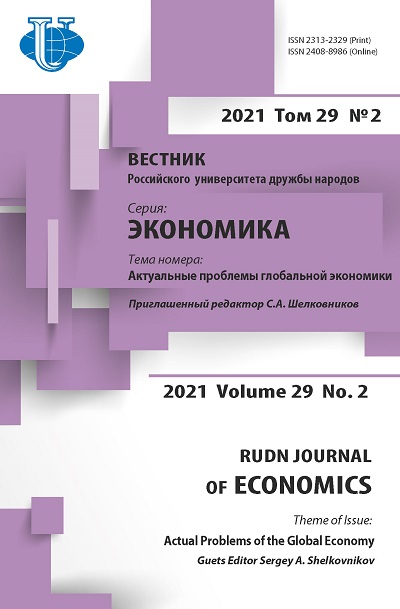Modern exchange rate formation in a resource-oriented economy: the institutional dimension
- Authors: Bunevich K.G.1, Gorbacheva T.A.1
-
Affiliations:
- Witte Moscow University
- Issue: Vol 29, No 2 (2021): ACTUAL PROBLEMS OF THE GLOBAL ECONOMY
- Pages: 266-277
- Section: WORLD CAPITAL MARKET
- URL: https://journals.rudn.ru/economics/article/view/26889
- DOI: https://doi.org/10.22363/2313-2329-2021-29-2-266-277
Cite item
Full Text
Abstract
There is an increasing need for in-depth theoretical and applied studies of the essence, structure and features of the formation of the exchange rate, the development of the mechanism of currency regulation in the Russian Federation, determining the degree of state regulation of currency relations, including due to the introduction of currency restrictions, clarifying the main criteria for the effectiveness of their application, as well as developing directions for improving the mechanism of currency regulation in the conditions of post-crisis economic development. The main purpose of this article was to consider the peculiarities of the formation of the exchange rate in a resource-oriented economy, which includes the Russian economy. The article uses general scientific methods, in particular, analysis, synthesis, comparison, as well as a systematic approach to the study of information. The value of the exchange rate for the economy is indicated. The main indicators of exchange rates and the main groups of factors affecting the exchange rate of the national currency are described.
About the authors
Konstantin G. Bunevich
Witte Moscow University
Author for correspondence.
Email: kbunevich@muiv.ru
PhD, Associate Professor, Head of the Department of Finance and Сredit
12 2nd Kozhukhovsky Proezd, bldg 1, Moscow, 115432, Russian FederationTatiana A. Gorbacheva
Witte Moscow University
Email: t-gorbacheva@bk.ru
PhD, Associate Professor, Department of Finance and Сredit
12 2nd Kozhukhovsky Proezd, bldg 1, Moscow, 115432, Russian FederationReferences
- Auty, R.M. (2001). Resource abundance and economic development. Oxford: Oxford University Press.
- Bova, E., Medas, P., & Poghosyan, T. (2016). Macroeconomic stability in resource-rich countries: The role of fiscal policy: IMF Working Paper WP/16/36. International Monetary Fund.
- Bozhechkova, A.V., & Trunin, P.V. (2016). Analysis of the dynamics of the real exchange rate of the ruble (p. 97). Moscow, “Delo” RANEPA Publ. (In Russ.)
- Bozhechkova, A.V., Sinelnikov-Murylev, S.G., & Trunin, P.V. (2020). Factors of the ruble exchange rate dynamics in the 2000s and 2010s. Economic Issues, (8), 5–22.
- Chernysh, N.A., & Buryanova, N.V. (2016). Exchange rate: Factors influencing its formation. Science and World, 2(12), 47–49. (In Russ.)
- Embulaev, V.N. (2017). The development of Russia’s economy and the “Dutch Disease”. The Herald of Vladivostok State University of Economics and Service, 9(2), 53–63. (In Russ.)
- Faltermeier, J., Lama, R., & Medina, J.P. (2017). Foreign exchange intervention and the Dutch disease: IMF Working Paper WP/17/70. International Monetary Fund.
- Gavrilova, E.N., & Bunevich, K.G. (2020). Factors of formation of the exchange rate of the Russian ruble. Current Issues of the Modern Economy, (9), 230–233. (In Russ.)
- Kholopov, A.V. (2018). Exchange rate policy in the system of macroeconomic regulation measures. Economic Horizons, (5), 107–113. (In Russ.)
- Kondratev, V. (2016). Resource-based economic growth. World Economy and International Relations, 60(1), 41–52. (In Russ.) https://doi.org/10.20542/0131-2227-2016-60-1-41-52
- Korechkov, Yu.V. (2020) Currency wars: Political and economic nature, causes and consequences. Theoretical Economy, (1), 29–34. (In Russ.)
- Kosarev, A. (2014). Purchasing power parity – a unique tool for international comparisons. Voprosy Statistiki, (5), 63–72. (In Russ.) https://doi.org/10.34023/2313-6383-2014-0-563-72
- Moiseev, S.R. (2016). Foreign exchange intervention. Motives of central banks and their tools. Russian Journal of Money and Finance, (3), 12–19. (In Russ.)
- Niyazbekova, Sh.U., & Bunevich, K.G. (2018). Mechanism of exchange rate formation. Vestnik RIAT, (4), 45–50. (In Russ.)
- Oleynikova, I.N. (2018). Key aspects of using sovereign funds in solving the structural problems of the national economy. Vestnik of Astrakhan State Technical University. Series: Economics, (2), 61–72. https://doi.org/10.24143/2073-5537-2018-2-61-72
- Prilepskiy, I.V. (2020). Impact of external currency exposures on macroeconomic policies. Voprosy Ekonomiki, (8), 23–40. https://doi.org/10.32609/0042-8736-2020-8-23-40
- Rodin, D.Ya., & Bulokhova, E.V. (2018). Exchange rate and factors influencing its forma- tion. Symbol of Science, (7), 70–74. (In Russ.)
- Sachs, J.D., & Warner, A.M. (1995). Natural resource abundance and economic growth. NBER Working Paper Series. Working Paper No 5398. Cambridge: National Bureau of Economic Research.
- Skurikhin, A.S. (2019). Aspects of interaction between Russia's financial and monetary policy. Current Problems and Prospects of Economic Development: Russian and Foreign Experience, (3), 92–102. (In Russ.)
- Solyannikova, S., & Bondarenko, N. (2019). Trends in the development of sovereign funds as a tool of budgetary policy. Economics, Taxes & Law, 12(1), 57–67.
- Tetyushin, A.V. (2020). Currency interventions of the Central Bank of the Russian Federation in the context of the coronavirus pandemic and falling oil prices. Economics and Business: Theory and Practice, (4–3), 93–97. (In Russ.)
- Zharikov, M. (2019). Currency wars within the existing international monetary system. Obshchestvo i Ekonomika, (8), 89–95. (In Russ). https://doi.org/10.31857/S020736760006129-0
- Zikunova, I.V. (2017). Fundamental factors of dollar-ruble exchange: Expectations for 2017. Scholarly Notes of Komsomolsk-na-Amure State Technical University, 2(1), 79–84. (In Russ.)
- Zubarev, A.V., & Trunin, P.V. (2014). Impact of the real exchange rate on economic activity in Russia. Studies on Russian Economic Development, (2), 92–102. (In Russ.)















